Report on Organizational Theory and Practice at Unilever plc
VerifiedAdded on 2023/06/10
|11
|3907
|316
Report
AI Summary
This report provides an in-depth analysis of Unilever plc's organizational theory and practice, focusing on its divisional organizational structure and role culture. The report examines the advantages and disadvantages of Unilever's product-based divisional structure, highlighting its impact on accountability, competition, and decision-making speed, while also acknowledging potential inefficiencies, rivalries, and strategic focus challenges. The analysis of Unilever's role culture explores its influence on employee efficiency, conflict resolution, and clarity in working roles, while also considering limitations related to change implementation and employee treatment. Furthermore, the report evaluates the impact of the organizational structure on management practices, emphasizing developmental opportunities and accountability, and discusses employee motivation within the context of Unilever's organizational culture. Desklib provides access to this and many other solved assignments for students.
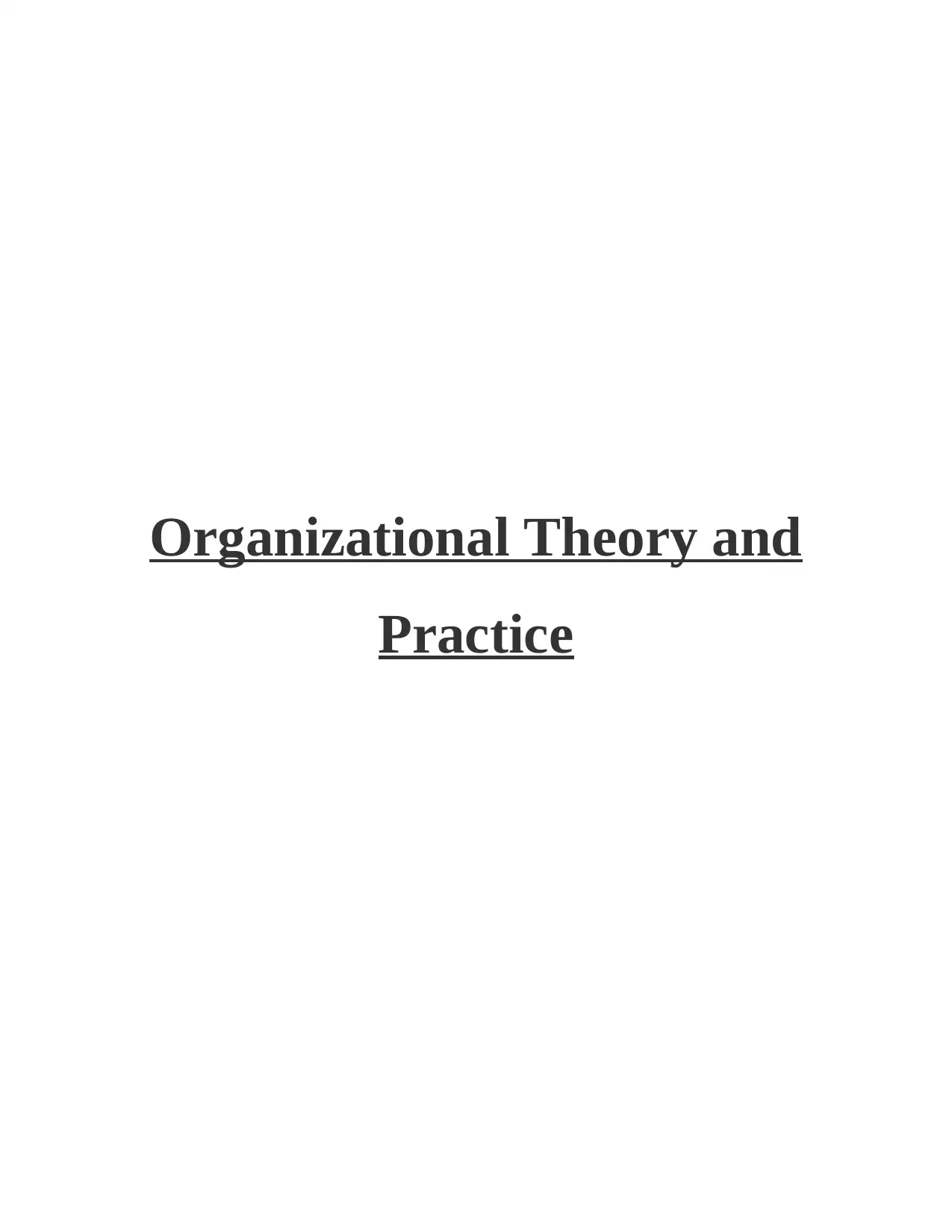
Organizational Theory and
Practice
Practice
Paraphrase This Document
Need a fresh take? Get an instant paraphrase of this document with our AI Paraphraser
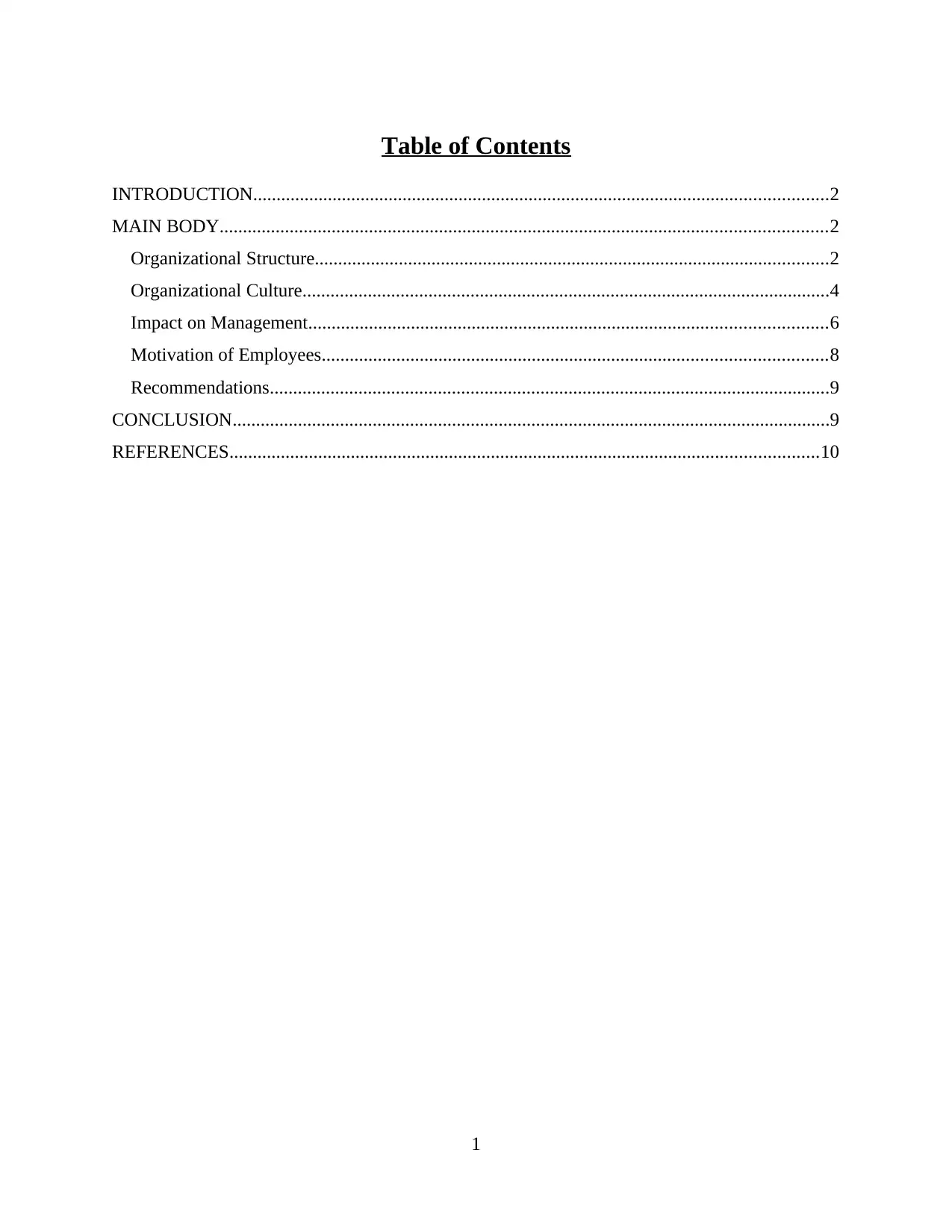
Table of Contents
INTRODUCTION...........................................................................................................................2
MAIN BODY..................................................................................................................................2
Organizational Structure..............................................................................................................2
Organizational Culture.................................................................................................................4
Impact on Management...............................................................................................................6
Motivation of Employees............................................................................................................8
Recommendations........................................................................................................................9
CONCLUSION................................................................................................................................9
REFERENCES..............................................................................................................................10
1
INTRODUCTION...........................................................................................................................2
MAIN BODY..................................................................................................................................2
Organizational Structure..............................................................................................................2
Organizational Culture.................................................................................................................4
Impact on Management...............................................................................................................6
Motivation of Employees............................................................................................................8
Recommendations........................................................................................................................9
CONCLUSION................................................................................................................................9
REFERENCES..............................................................................................................................10
1
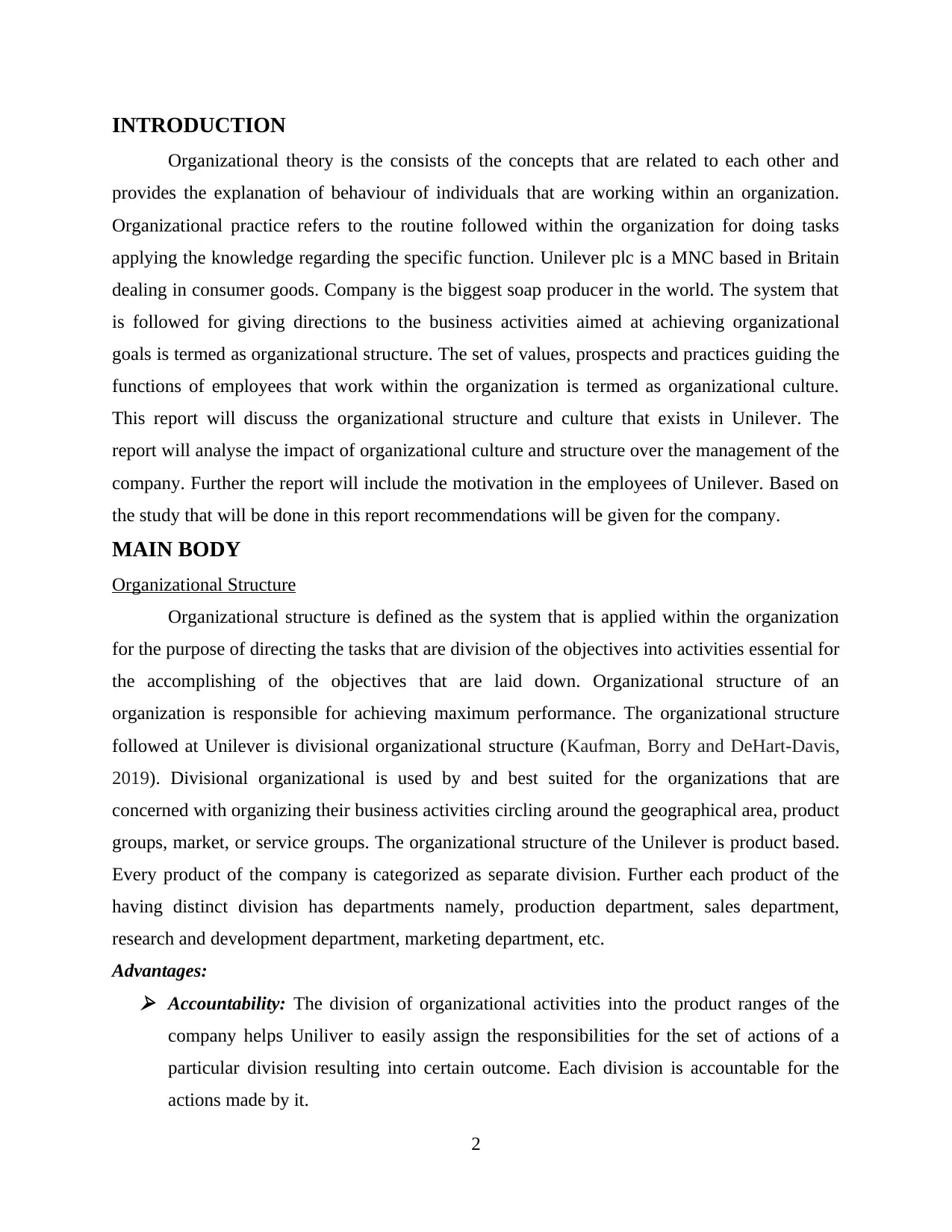
INTRODUCTION
Organizational theory is the consists of the concepts that are related to each other and
provides the explanation of behaviour of individuals that are working within an organization.
Organizational practice refers to the routine followed within the organization for doing tasks
applying the knowledge regarding the specific function. Unilever plc is a MNC based in Britain
dealing in consumer goods. Company is the biggest soap producer in the world. The system that
is followed for giving directions to the business activities aimed at achieving organizational
goals is termed as organizational structure. The set of values, prospects and practices guiding the
functions of employees that work within the organization is termed as organizational culture.
This report will discuss the organizational structure and culture that exists in Unilever. The
report will analyse the impact of organizational culture and structure over the management of the
company. Further the report will include the motivation in the employees of Unilever. Based on
the study that will be done in this report recommendations will be given for the company.
MAIN BODY
Organizational Structure
Organizational structure is defined as the system that is applied within the organization
for the purpose of directing the tasks that are division of the objectives into activities essential for
the accomplishing of the objectives that are laid down. Organizational structure of an
organization is responsible for achieving maximum performance. The organizational structure
followed at Unilever is divisional organizational structure (Kaufman, Borry and DeHart‐Davis,
2019). Divisional organizational is used by and best suited for the organizations that are
concerned with organizing their business activities circling around the geographical area, product
groups, market, or service groups. The organizational structure of the Unilever is product based.
Every product of the company is categorized as separate division. Further each product of the
having distinct division has departments namely, production department, sales department,
research and development department, marketing department, etc.
Advantages: Accountability: The division of organizational activities into the product ranges of the
company helps Uniliver to easily assign the responsibilities for the set of actions of a
particular division resulting into certain outcome. Each division is accountable for the
actions made by it.
2
Organizational theory is the consists of the concepts that are related to each other and
provides the explanation of behaviour of individuals that are working within an organization.
Organizational practice refers to the routine followed within the organization for doing tasks
applying the knowledge regarding the specific function. Unilever plc is a MNC based in Britain
dealing in consumer goods. Company is the biggest soap producer in the world. The system that
is followed for giving directions to the business activities aimed at achieving organizational
goals is termed as organizational structure. The set of values, prospects and practices guiding the
functions of employees that work within the organization is termed as organizational culture.
This report will discuss the organizational structure and culture that exists in Unilever. The
report will analyse the impact of organizational culture and structure over the management of the
company. Further the report will include the motivation in the employees of Unilever. Based on
the study that will be done in this report recommendations will be given for the company.
MAIN BODY
Organizational Structure
Organizational structure is defined as the system that is applied within the organization
for the purpose of directing the tasks that are division of the objectives into activities essential for
the accomplishing of the objectives that are laid down. Organizational structure of an
organization is responsible for achieving maximum performance. The organizational structure
followed at Unilever is divisional organizational structure (Kaufman, Borry and DeHart‐Davis,
2019). Divisional organizational is used by and best suited for the organizations that are
concerned with organizing their business activities circling around the geographical area, product
groups, market, or service groups. The organizational structure of the Unilever is product based.
Every product of the company is categorized as separate division. Further each product of the
having distinct division has departments namely, production department, sales department,
research and development department, marketing department, etc.
Advantages: Accountability: The division of organizational activities into the product ranges of the
company helps Uniliver to easily assign the responsibilities for the set of actions of a
particular division resulting into certain outcome. Each division is accountable for the
actions made by it.
2
⊘ This is a preview!⊘
Do you want full access?
Subscribe today to unlock all pages.

Trusted by 1+ million students worldwide
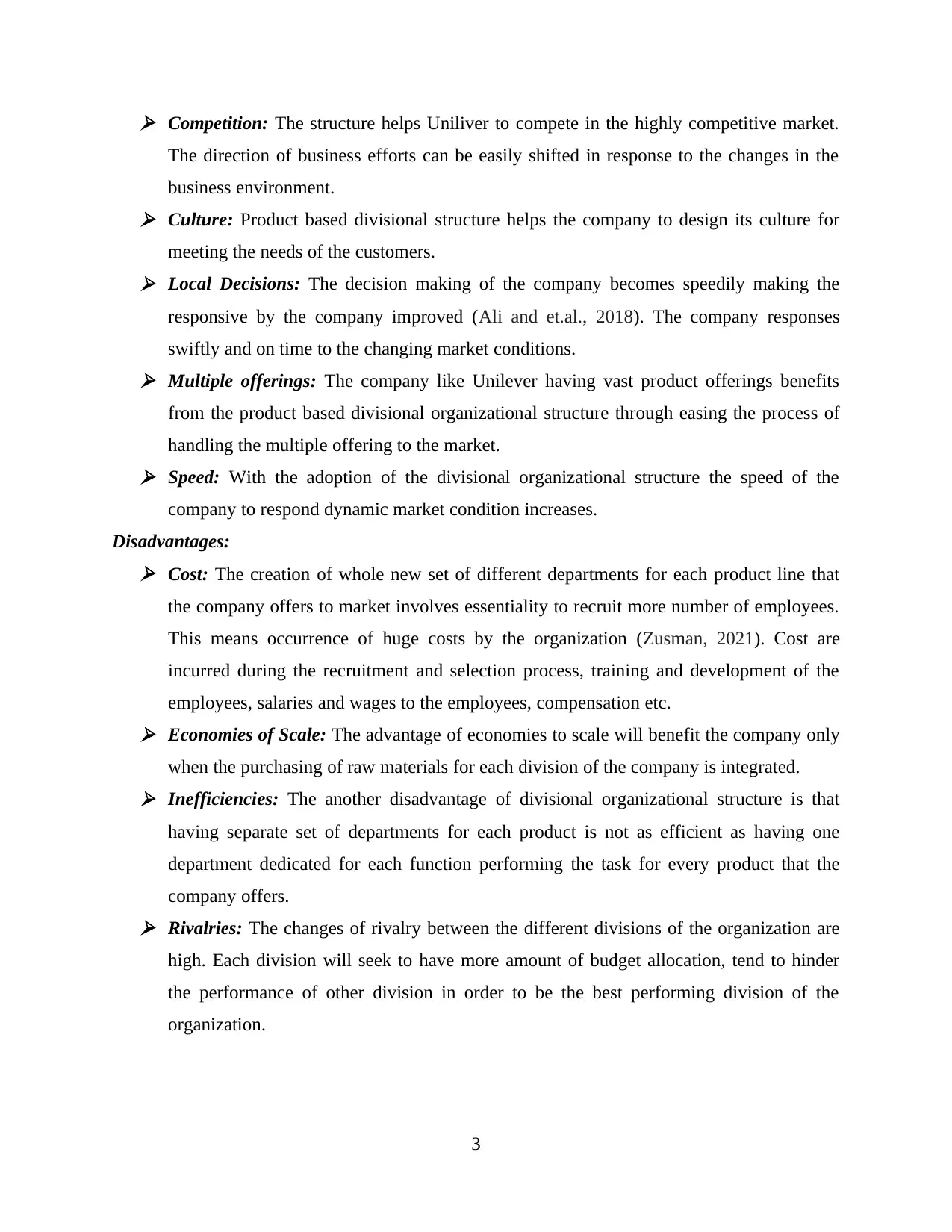
Competition: The structure helps Uniliver to compete in the highly competitive market.
The direction of business efforts can be easily shifted in response to the changes in the
business environment. Culture: Product based divisional structure helps the company to design its culture for
meeting the needs of the customers. Local Decisions: The decision making of the company becomes speedily making the
responsive by the company improved (Ali and et.al., 2018). The company responses
swiftly and on time to the changing market conditions. Multiple offerings: The company like Unilever having vast product offerings benefits
from the product based divisional organizational structure through easing the process of
handling the multiple offering to the market. Speed: With the adoption of the divisional organizational structure the speed of the
company to respond dynamic market condition increases.
Disadvantages: Cost: The creation of whole new set of different departments for each product line that
the company offers to market involves essentiality to recruit more number of employees.
This means occurrence of huge costs by the organization (Zusman, 2021). Cost are
incurred during the recruitment and selection process, training and development of the
employees, salaries and wages to the employees, compensation etc. Economies of Scale: The advantage of economies to scale will benefit the company only
when the purchasing of raw materials for each division of the company is integrated. Inefficiencies: The another disadvantage of divisional organizational structure is that
having separate set of departments for each product is not as efficient as having one
department dedicated for each function performing the task for every product that the
company offers. Rivalries: The changes of rivalry between the different divisions of the organization are
high. Each division will seek to have more amount of budget allocation, tend to hinder
the performance of other division in order to be the best performing division of the
organization.
3
The direction of business efforts can be easily shifted in response to the changes in the
business environment. Culture: Product based divisional structure helps the company to design its culture for
meeting the needs of the customers. Local Decisions: The decision making of the company becomes speedily making the
responsive by the company improved (Ali and et.al., 2018). The company responses
swiftly and on time to the changing market conditions. Multiple offerings: The company like Unilever having vast product offerings benefits
from the product based divisional organizational structure through easing the process of
handling the multiple offering to the market. Speed: With the adoption of the divisional organizational structure the speed of the
company to respond dynamic market condition increases.
Disadvantages: Cost: The creation of whole new set of different departments for each product line that
the company offers to market involves essentiality to recruit more number of employees.
This means occurrence of huge costs by the organization (Zusman, 2021). Cost are
incurred during the recruitment and selection process, training and development of the
employees, salaries and wages to the employees, compensation etc. Economies of Scale: The advantage of economies to scale will benefit the company only
when the purchasing of raw materials for each division of the company is integrated. Inefficiencies: The another disadvantage of divisional organizational structure is that
having separate set of departments for each product is not as efficient as having one
department dedicated for each function performing the task for every product that the
company offers. Rivalries: The changes of rivalry between the different divisions of the organization are
high. Each division will seek to have more amount of budget allocation, tend to hinder
the performance of other division in order to be the best performing division of the
organization.
3
Paraphrase This Document
Need a fresh take? Get an instant paraphrase of this document with our AI Paraphraser
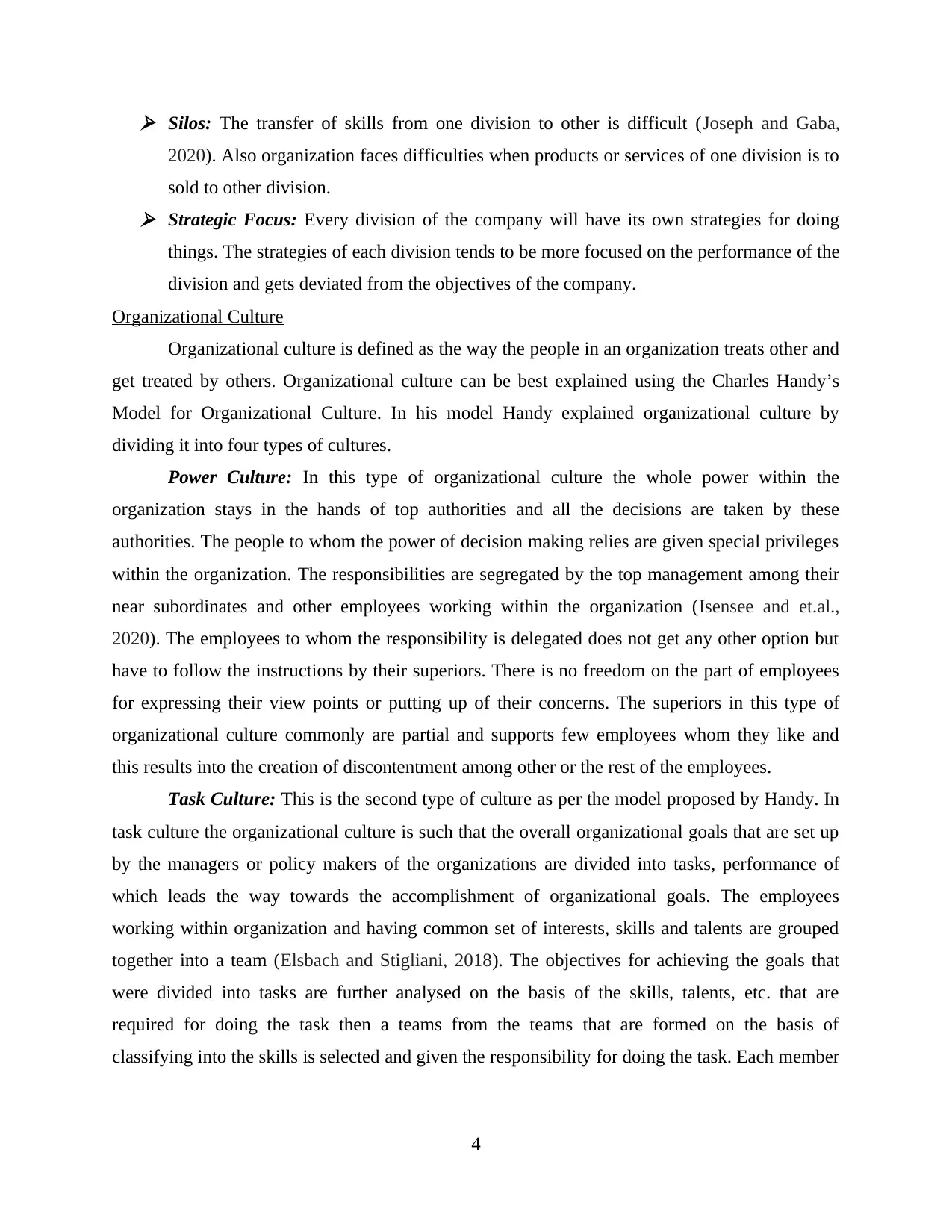
Silos: The transfer of skills from one division to other is difficult (Joseph and Gaba,
2020). Also organization faces difficulties when products or services of one division is to
sold to other division. Strategic Focus: Every division of the company will have its own strategies for doing
things. The strategies of each division tends to be more focused on the performance of the
division and gets deviated from the objectives of the company.
Organizational Culture
Organizational culture is defined as the way the people in an organization treats other and
get treated by others. Organizational culture can be best explained using the Charles Handy’s
Model for Organizational Culture. In his model Handy explained organizational culture by
dividing it into four types of cultures.
Power Culture: In this type of organizational culture the whole power within the
organization stays in the hands of top authorities and all the decisions are taken by these
authorities. The people to whom the power of decision making relies are given special privileges
within the organization. The responsibilities are segregated by the top management among their
near subordinates and other employees working within the organization (Isensee and et.al.,
2020). The employees to whom the responsibility is delegated does not get any other option but
have to follow the instructions by their superiors. There is no freedom on the part of employees
for expressing their view points or putting up of their concerns. The superiors in this type of
organizational culture commonly are partial and supports few employees whom they like and
this results into the creation of discontentment among other or the rest of the employees.
Task Culture: This is the second type of culture as per the model proposed by Handy. In
task culture the organizational culture is such that the overall organizational goals that are set up
by the managers or policy makers of the organizations are divided into tasks, performance of
which leads the way towards the accomplishment of organizational goals. The employees
working within organization and having common set of interests, skills and talents are grouped
together into a team (Elsbach and Stigliani, 2018). The objectives for achieving the goals that
were divided into tasks are further analysed on the basis of the skills, talents, etc. that are
required for doing the task then a teams from the teams that are formed on the basis of
classifying into the skills is selected and given the responsibility for doing the task. Each member
4
2020). Also organization faces difficulties when products or services of one division is to
sold to other division. Strategic Focus: Every division of the company will have its own strategies for doing
things. The strategies of each division tends to be more focused on the performance of the
division and gets deviated from the objectives of the company.
Organizational Culture
Organizational culture is defined as the way the people in an organization treats other and
get treated by others. Organizational culture can be best explained using the Charles Handy’s
Model for Organizational Culture. In his model Handy explained organizational culture by
dividing it into four types of cultures.
Power Culture: In this type of organizational culture the whole power within the
organization stays in the hands of top authorities and all the decisions are taken by these
authorities. The people to whom the power of decision making relies are given special privileges
within the organization. The responsibilities are segregated by the top management among their
near subordinates and other employees working within the organization (Isensee and et.al.,
2020). The employees to whom the responsibility is delegated does not get any other option but
have to follow the instructions by their superiors. There is no freedom on the part of employees
for expressing their view points or putting up of their concerns. The superiors in this type of
organizational culture commonly are partial and supports few employees whom they like and
this results into the creation of discontentment among other or the rest of the employees.
Task Culture: This is the second type of culture as per the model proposed by Handy. In
task culture the organizational culture is such that the overall organizational goals that are set up
by the managers or policy makers of the organizations are divided into tasks, performance of
which leads the way towards the accomplishment of organizational goals. The employees
working within organization and having common set of interests, skills and talents are grouped
together into a team (Elsbach and Stigliani, 2018). The objectives for achieving the goals that
were divided into tasks are further analysed on the basis of the skills, talents, etc. that are
required for doing the task then a teams from the teams that are formed on the basis of
classifying into the skills is selected and given the responsibility for doing the task. Each member
4
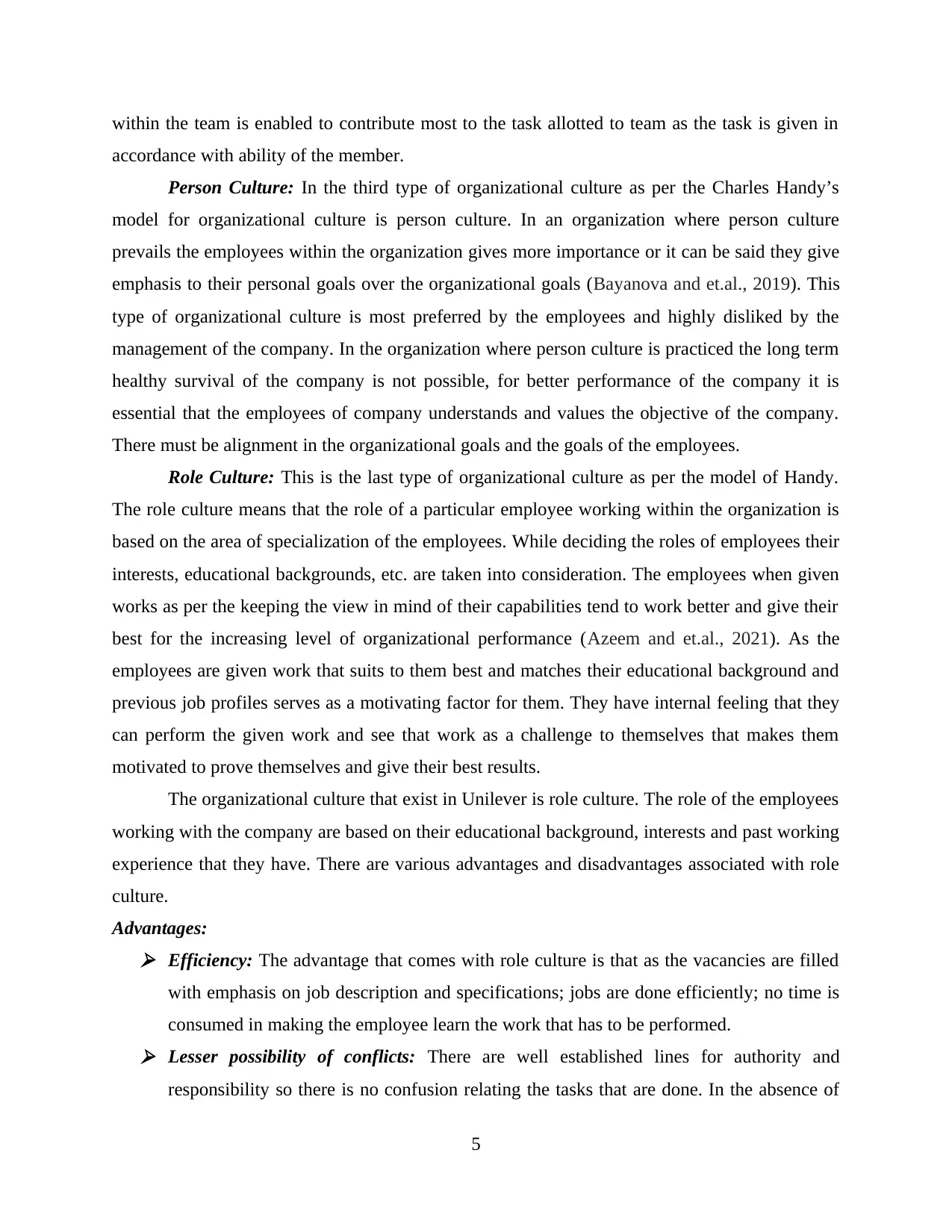
within the team is enabled to contribute most to the task allotted to team as the task is given in
accordance with ability of the member.
Person Culture: In the third type of organizational culture as per the Charles Handy’s
model for organizational culture is person culture. In an organization where person culture
prevails the employees within the organization gives more importance or it can be said they give
emphasis to their personal goals over the organizational goals (Bayanova and et.al., 2019). This
type of organizational culture is most preferred by the employees and highly disliked by the
management of the company. In the organization where person culture is practiced the long term
healthy survival of the company is not possible, for better performance of the company it is
essential that the employees of company understands and values the objective of the company.
There must be alignment in the organizational goals and the goals of the employees.
Role Culture: This is the last type of organizational culture as per the model of Handy.
The role culture means that the role of a particular employee working within the organization is
based on the area of specialization of the employees. While deciding the roles of employees their
interests, educational backgrounds, etc. are taken into consideration. The employees when given
works as per the keeping the view in mind of their capabilities tend to work better and give their
best for the increasing level of organizational performance (Azeem and et.al., 2021). As the
employees are given work that suits to them best and matches their educational background and
previous job profiles serves as a motivating factor for them. They have internal feeling that they
can perform the given work and see that work as a challenge to themselves that makes them
motivated to prove themselves and give their best results.
The organizational culture that exist in Unilever is role culture. The role of the employees
working with the company are based on their educational background, interests and past working
experience that they have. There are various advantages and disadvantages associated with role
culture.
Advantages: Efficiency: The advantage that comes with role culture is that as the vacancies are filled
with emphasis on job description and specifications; jobs are done efficiently; no time is
consumed in making the employee learn the work that has to be performed. Lesser possibility of conflicts: There are well established lines for authority and
responsibility so there is no confusion relating the tasks that are done. In the absence of
5
accordance with ability of the member.
Person Culture: In the third type of organizational culture as per the Charles Handy’s
model for organizational culture is person culture. In an organization where person culture
prevails the employees within the organization gives more importance or it can be said they give
emphasis to their personal goals over the organizational goals (Bayanova and et.al., 2019). This
type of organizational culture is most preferred by the employees and highly disliked by the
management of the company. In the organization where person culture is practiced the long term
healthy survival of the company is not possible, for better performance of the company it is
essential that the employees of company understands and values the objective of the company.
There must be alignment in the organizational goals and the goals of the employees.
Role Culture: This is the last type of organizational culture as per the model of Handy.
The role culture means that the role of a particular employee working within the organization is
based on the area of specialization of the employees. While deciding the roles of employees their
interests, educational backgrounds, etc. are taken into consideration. The employees when given
works as per the keeping the view in mind of their capabilities tend to work better and give their
best for the increasing level of organizational performance (Azeem and et.al., 2021). As the
employees are given work that suits to them best and matches their educational background and
previous job profiles serves as a motivating factor for them. They have internal feeling that they
can perform the given work and see that work as a challenge to themselves that makes them
motivated to prove themselves and give their best results.
The organizational culture that exist in Unilever is role culture. The role of the employees
working with the company are based on their educational background, interests and past working
experience that they have. There are various advantages and disadvantages associated with role
culture.
Advantages: Efficiency: The advantage that comes with role culture is that as the vacancies are filled
with emphasis on job description and specifications; jobs are done efficiently; no time is
consumed in making the employee learn the work that has to be performed. Lesser possibility of conflicts: There are well established lines for authority and
responsibility so there is no confusion relating the tasks that are done. In the absence of
5
⊘ This is a preview!⊘
Do you want full access?
Subscribe today to unlock all pages.

Trusted by 1+ million students worldwide
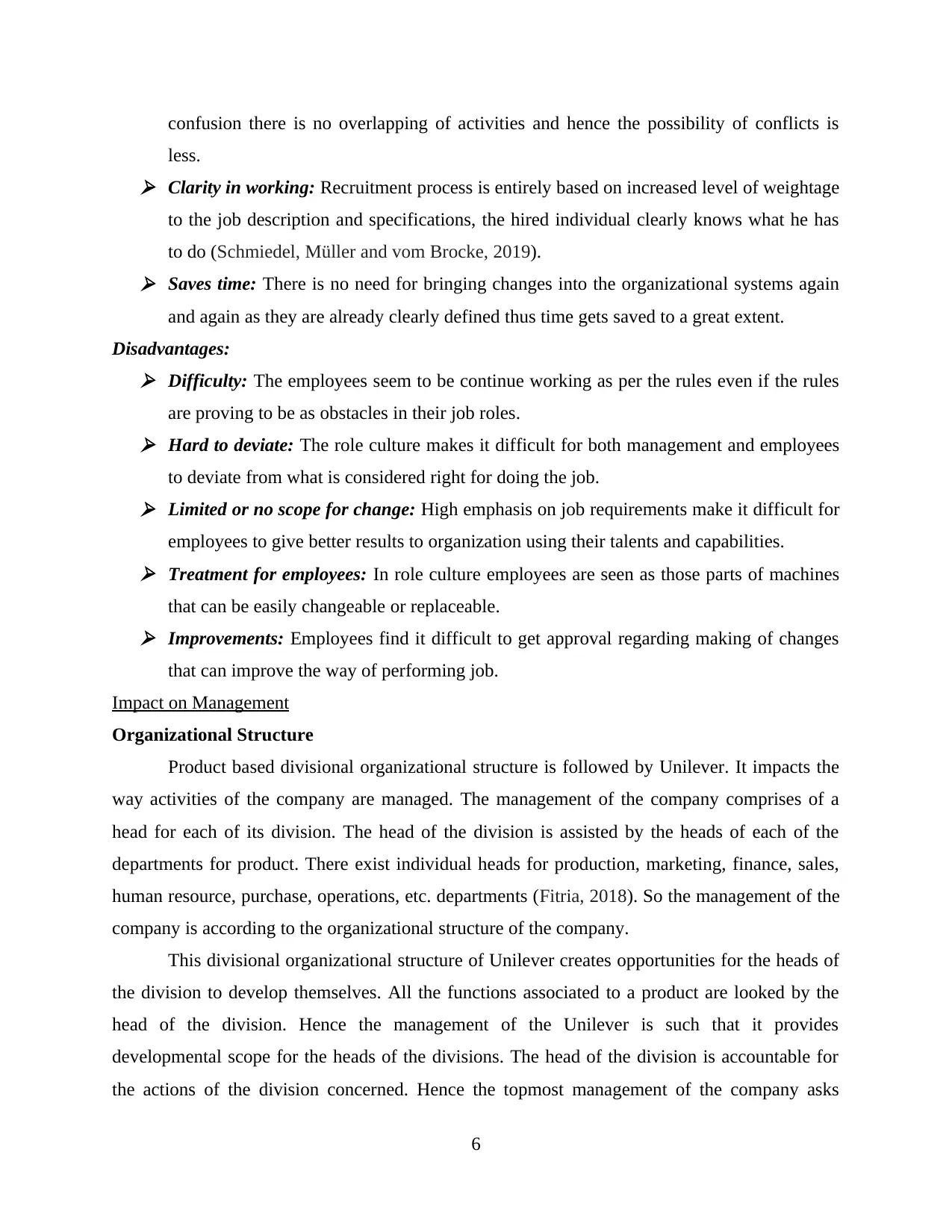
confusion there is no overlapping of activities and hence the possibility of conflicts is
less. Clarity in working: Recruitment process is entirely based on increased level of weightage
to the job description and specifications, the hired individual clearly knows what he has
to do (Schmiedel, Müller and vom Brocke, 2019). Saves time: There is no need for bringing changes into the organizational systems again
and again as they are already clearly defined thus time gets saved to a great extent.
Disadvantages: Difficulty: The employees seem to be continue working as per the rules even if the rules
are proving to be as obstacles in their job roles. Hard to deviate: The role culture makes it difficult for both management and employees
to deviate from what is considered right for doing the job. Limited or no scope for change: High emphasis on job requirements make it difficult for
employees to give better results to organization using their talents and capabilities. Treatment for employees: In role culture employees are seen as those parts of machines
that can be easily changeable or replaceable. Improvements: Employees find it difficult to get approval regarding making of changes
that can improve the way of performing job.
Impact on Management
Organizational Structure
Product based divisional organizational structure is followed by Unilever. It impacts the
way activities of the company are managed. The management of the company comprises of a
head for each of its division. The head of the division is assisted by the heads of each of the
departments for product. There exist individual heads for production, marketing, finance, sales,
human resource, purchase, operations, etc. departments (Fitria, 2018). So the management of the
company is according to the organizational structure of the company.
This divisional organizational structure of Unilever creates opportunities for the heads of
the division to develop themselves. All the functions associated to a product are looked by the
head of the division. Hence the management of the Unilever is such that it provides
developmental scope for the heads of the divisions. The head of the division is accountable for
the actions of the division concerned. Hence the topmost management of the company asks
6
less. Clarity in working: Recruitment process is entirely based on increased level of weightage
to the job description and specifications, the hired individual clearly knows what he has
to do (Schmiedel, Müller and vom Brocke, 2019). Saves time: There is no need for bringing changes into the organizational systems again
and again as they are already clearly defined thus time gets saved to a great extent.
Disadvantages: Difficulty: The employees seem to be continue working as per the rules even if the rules
are proving to be as obstacles in their job roles. Hard to deviate: The role culture makes it difficult for both management and employees
to deviate from what is considered right for doing the job. Limited or no scope for change: High emphasis on job requirements make it difficult for
employees to give better results to organization using their talents and capabilities. Treatment for employees: In role culture employees are seen as those parts of machines
that can be easily changeable or replaceable. Improvements: Employees find it difficult to get approval regarding making of changes
that can improve the way of performing job.
Impact on Management
Organizational Structure
Product based divisional organizational structure is followed by Unilever. It impacts the
way activities of the company are managed. The management of the company comprises of a
head for each of its division. The head of the division is assisted by the heads of each of the
departments for product. There exist individual heads for production, marketing, finance, sales,
human resource, purchase, operations, etc. departments (Fitria, 2018). So the management of the
company is according to the organizational structure of the company.
This divisional organizational structure of Unilever creates opportunities for the heads of
the division to develop themselves. All the functions associated to a product are looked by the
head of the division. Hence the management of the Unilever is such that it provides
developmental scope for the heads of the divisions. The head of the division is accountable for
the actions of the division concerned. Hence the topmost management of the company asks
6
Paraphrase This Document
Need a fresh take? Get an instant paraphrase of this document with our AI Paraphraser
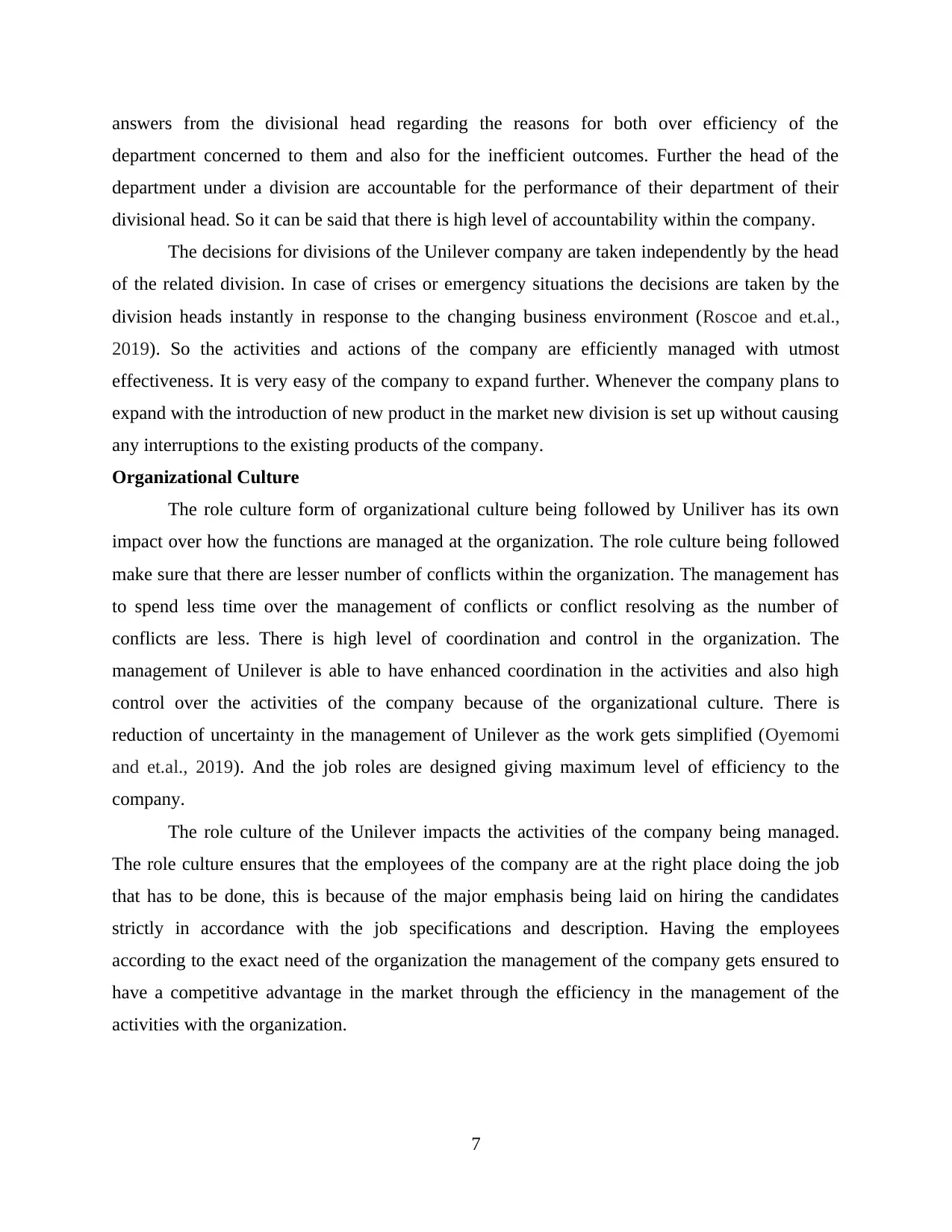
answers from the divisional head regarding the reasons for both over efficiency of the
department concerned to them and also for the inefficient outcomes. Further the head of the
department under a division are accountable for the performance of their department of their
divisional head. So it can be said that there is high level of accountability within the company.
The decisions for divisions of the Unilever company are taken independently by the head
of the related division. In case of crises or emergency situations the decisions are taken by the
division heads instantly in response to the changing business environment (Roscoe and et.al.,
2019). So the activities and actions of the company are efficiently managed with utmost
effectiveness. It is very easy of the company to expand further. Whenever the company plans to
expand with the introduction of new product in the market new division is set up without causing
any interruptions to the existing products of the company.
Organizational Culture
The role culture form of organizational culture being followed by Uniliver has its own
impact over how the functions are managed at the organization. The role culture being followed
make sure that there are lesser number of conflicts within the organization. The management has
to spend less time over the management of conflicts or conflict resolving as the number of
conflicts are less. There is high level of coordination and control in the organization. The
management of Unilever is able to have enhanced coordination in the activities and also high
control over the activities of the company because of the organizational culture. There is
reduction of uncertainty in the management of Unilever as the work gets simplified (Oyemomi
and et.al., 2019). And the job roles are designed giving maximum level of efficiency to the
company.
The role culture of the Unilever impacts the activities of the company being managed.
The role culture ensures that the employees of the company are at the right place doing the job
that has to be done, this is because of the major emphasis being laid on hiring the candidates
strictly in accordance with the job specifications and description. Having the employees
according to the exact need of the organization the management of the company gets ensured to
have a competitive advantage in the market through the efficiency in the management of the
activities with the organization.
7
department concerned to them and also for the inefficient outcomes. Further the head of the
department under a division are accountable for the performance of their department of their
divisional head. So it can be said that there is high level of accountability within the company.
The decisions for divisions of the Unilever company are taken independently by the head
of the related division. In case of crises or emergency situations the decisions are taken by the
division heads instantly in response to the changing business environment (Roscoe and et.al.,
2019). So the activities and actions of the company are efficiently managed with utmost
effectiveness. It is very easy of the company to expand further. Whenever the company plans to
expand with the introduction of new product in the market new division is set up without causing
any interruptions to the existing products of the company.
Organizational Culture
The role culture form of organizational culture being followed by Uniliver has its own
impact over how the functions are managed at the organization. The role culture being followed
make sure that there are lesser number of conflicts within the organization. The management has
to spend less time over the management of conflicts or conflict resolving as the number of
conflicts are less. There is high level of coordination and control in the organization. The
management of Unilever is able to have enhanced coordination in the activities and also high
control over the activities of the company because of the organizational culture. There is
reduction of uncertainty in the management of Unilever as the work gets simplified (Oyemomi
and et.al., 2019). And the job roles are designed giving maximum level of efficiency to the
company.
The role culture of the Unilever impacts the activities of the company being managed.
The role culture ensures that the employees of the company are at the right place doing the job
that has to be done, this is because of the major emphasis being laid on hiring the candidates
strictly in accordance with the job specifications and description. Having the employees
according to the exact need of the organization the management of the company gets ensured to
have a competitive advantage in the market through the efficiency in the management of the
activities with the organization.
7

Motivation of Employees
The company aims at providing the most appropriate and positive working environment
to its customers. Company always tries to support both physical and mental wellbeing along with
the emotional wellbeing of the employees. The company in its practices allows employees to
develop themselves and enhance their career. Company believes the physical and mental health
of the employees is affected by the environment of their work place. Employees of the company
gets motivated with the way it supports the wellbeing of the employees. The company has
divided the term wellbeing into four parts: physical, purposeful, mental and emotional. It looks
afters the health, fitness, nutrition, energy levels and sleep of the employees under the physical
aspect of the company (Alsuwaidi and et.al., 2020). The outlook of the company determines
what affects the purpose of the employees making them feel like to remain associated with the
company. There are special sessions held that the company for helping employees to manage
their choices regarding mental health, challenge and pressure management. Employees of the
company are further motivated with the outlining of the methods that can make them feel
positive and face the challenges coming in their work. There are various techniques by which the
company motivates its employees to work in positive direction towards the organizational goal
achievement (Majid and et.al., 2021).
Appreciation: Company keep close track of the performances of its employees. The good
work of the employees is appreciated. Both monetary and non-monetary forms of
appreciation are used by the company for boosting the morale and increasing the level of
motivation in employees.
Understanding: Company shows it its practices that it understands the concern of its
employees. Human resource teams of the company takes care that each and every
grievance of the employees of the company gets addressed by the company.
Job security: Another way of company for motivating the employees is to assure its
employees regarding their jobs being secured. Company never dismiss any employee
without solid reasons.
Opportunities: The employees associated with the company are motivated with the career
growth opportunities that it gives to them through effective training and development
programs.
8
The company aims at providing the most appropriate and positive working environment
to its customers. Company always tries to support both physical and mental wellbeing along with
the emotional wellbeing of the employees. The company in its practices allows employees to
develop themselves and enhance their career. Company believes the physical and mental health
of the employees is affected by the environment of their work place. Employees of the company
gets motivated with the way it supports the wellbeing of the employees. The company has
divided the term wellbeing into four parts: physical, purposeful, mental and emotional. It looks
afters the health, fitness, nutrition, energy levels and sleep of the employees under the physical
aspect of the company (Alsuwaidi and et.al., 2020). The outlook of the company determines
what affects the purpose of the employees making them feel like to remain associated with the
company. There are special sessions held that the company for helping employees to manage
their choices regarding mental health, challenge and pressure management. Employees of the
company are further motivated with the outlining of the methods that can make them feel
positive and face the challenges coming in their work. There are various techniques by which the
company motivates its employees to work in positive direction towards the organizational goal
achievement (Majid and et.al., 2021).
Appreciation: Company keep close track of the performances of its employees. The good
work of the employees is appreciated. Both monetary and non-monetary forms of
appreciation are used by the company for boosting the morale and increasing the level of
motivation in employees.
Understanding: Company shows it its practices that it understands the concern of its
employees. Human resource teams of the company takes care that each and every
grievance of the employees of the company gets addressed by the company.
Job security: Another way of company for motivating the employees is to assure its
employees regarding their jobs being secured. Company never dismiss any employee
without solid reasons.
Opportunities: The employees associated with the company are motivated with the career
growth opportunities that it gives to them through effective training and development
programs.
8
⊘ This is a preview!⊘
Do you want full access?
Subscribe today to unlock all pages.

Trusted by 1+ million students worldwide
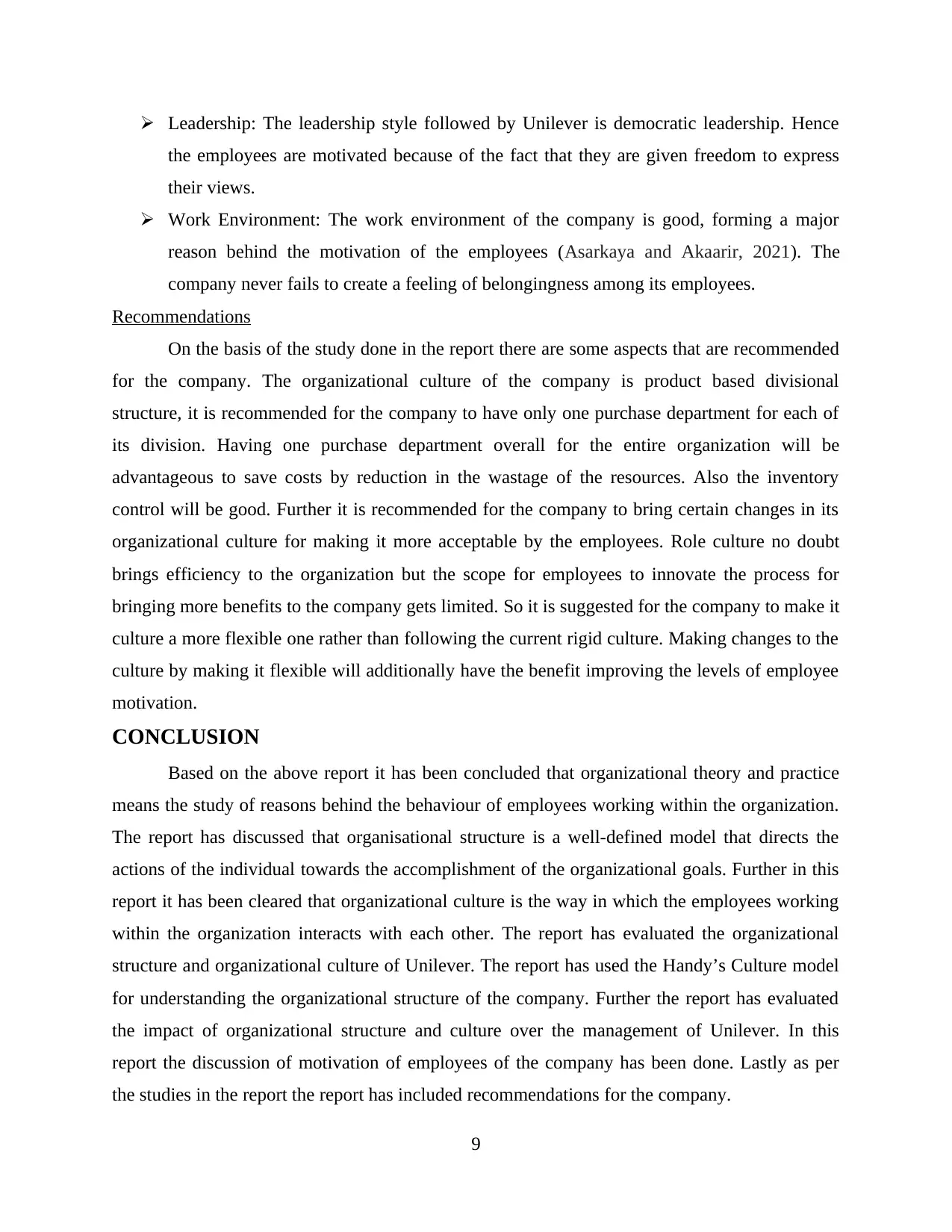
Leadership: The leadership style followed by Unilever is democratic leadership. Hence
the employees are motivated because of the fact that they are given freedom to express
their views.
Work Environment: The work environment of the company is good, forming a major
reason behind the motivation of the employees (Asarkaya and Akaarir, 2021). The
company never fails to create a feeling of belongingness among its employees.
Recommendations
On the basis of the study done in the report there are some aspects that are recommended
for the company. The organizational culture of the company is product based divisional
structure, it is recommended for the company to have only one purchase department for each of
its division. Having one purchase department overall for the entire organization will be
advantageous to save costs by reduction in the wastage of the resources. Also the inventory
control will be good. Further it is recommended for the company to bring certain changes in its
organizational culture for making it more acceptable by the employees. Role culture no doubt
brings efficiency to the organization but the scope for employees to innovate the process for
bringing more benefits to the company gets limited. So it is suggested for the company to make it
culture a more flexible one rather than following the current rigid culture. Making changes to the
culture by making it flexible will additionally have the benefit improving the levels of employee
motivation.
CONCLUSION
Based on the above report it has been concluded that organizational theory and practice
means the study of reasons behind the behaviour of employees working within the organization.
The report has discussed that organisational structure is a well-defined model that directs the
actions of the individual towards the accomplishment of the organizational goals. Further in this
report it has been cleared that organizational culture is the way in which the employees working
within the organization interacts with each other. The report has evaluated the organizational
structure and organizational culture of Unilever. The report has used the Handy’s Culture model
for understanding the organizational structure of the company. Further the report has evaluated
the impact of organizational structure and culture over the management of Unilever. In this
report the discussion of motivation of employees of the company has been done. Lastly as per
the studies in the report the report has included recommendations for the company.
9
the employees are motivated because of the fact that they are given freedom to express
their views.
Work Environment: The work environment of the company is good, forming a major
reason behind the motivation of the employees (Asarkaya and Akaarir, 2021). The
company never fails to create a feeling of belongingness among its employees.
Recommendations
On the basis of the study done in the report there are some aspects that are recommended
for the company. The organizational culture of the company is product based divisional
structure, it is recommended for the company to have only one purchase department for each of
its division. Having one purchase department overall for the entire organization will be
advantageous to save costs by reduction in the wastage of the resources. Also the inventory
control will be good. Further it is recommended for the company to bring certain changes in its
organizational culture for making it more acceptable by the employees. Role culture no doubt
brings efficiency to the organization but the scope for employees to innovate the process for
bringing more benefits to the company gets limited. So it is suggested for the company to make it
culture a more flexible one rather than following the current rigid culture. Making changes to the
culture by making it flexible will additionally have the benefit improving the levels of employee
motivation.
CONCLUSION
Based on the above report it has been concluded that organizational theory and practice
means the study of reasons behind the behaviour of employees working within the organization.
The report has discussed that organisational structure is a well-defined model that directs the
actions of the individual towards the accomplishment of the organizational goals. Further in this
report it has been cleared that organizational culture is the way in which the employees working
within the organization interacts with each other. The report has evaluated the organizational
structure and organizational culture of Unilever. The report has used the Handy’s Culture model
for understanding the organizational structure of the company. Further the report has evaluated
the impact of organizational structure and culture over the management of Unilever. In this
report the discussion of motivation of employees of the company has been done. Lastly as per
the studies in the report the report has included recommendations for the company.
9
Paraphrase This Document
Need a fresh take? Get an instant paraphrase of this document with our AI Paraphraser
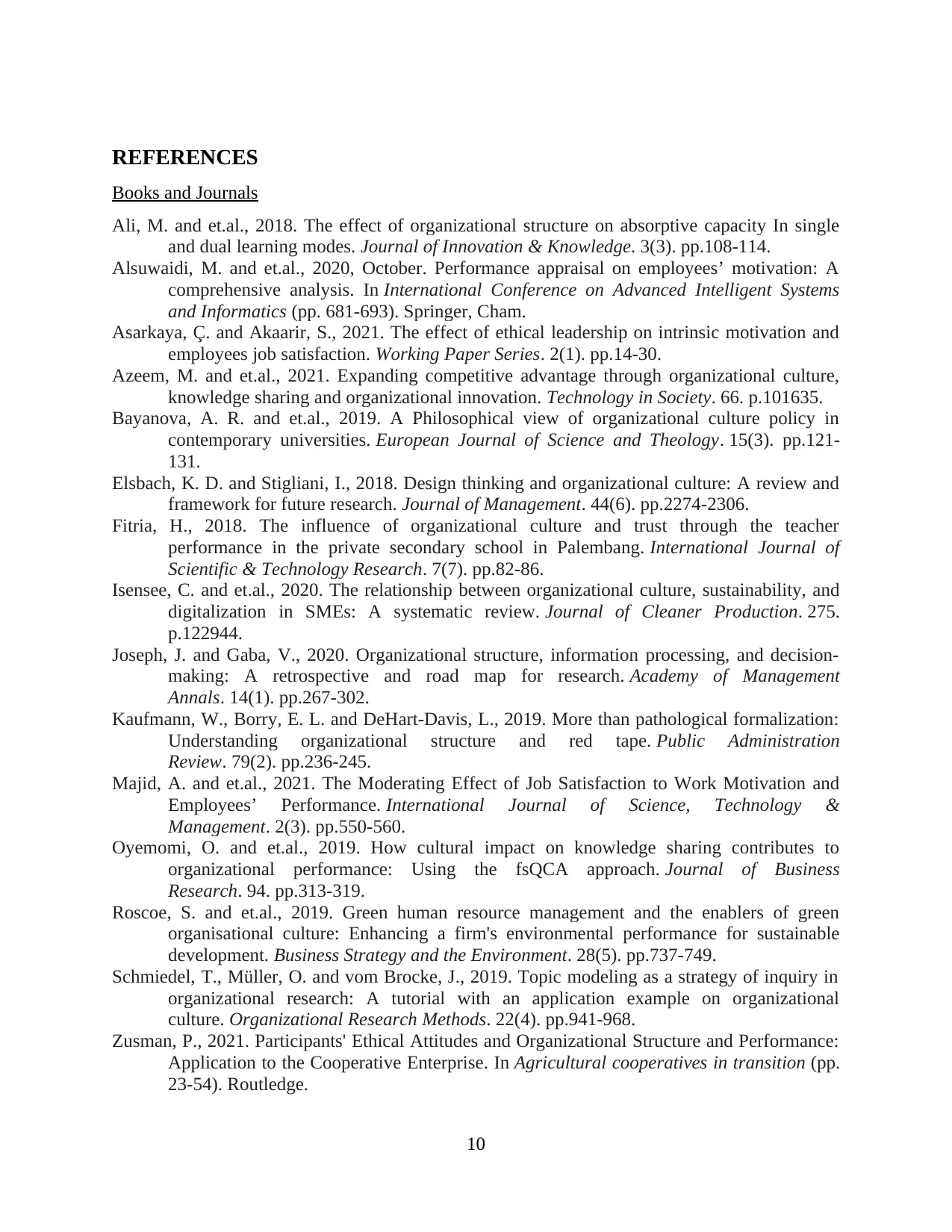
REFERENCES
Books and Journals
Ali, M. and et.al., 2018. The effect of organizational structure on absorptive capacity In single
and dual learning modes. Journal of Innovation & Knowledge. 3(3). pp.108-114.
Alsuwaidi, M. and et.al., 2020, October. Performance appraisal on employees’ motivation: A
comprehensive analysis. In International Conference on Advanced Intelligent Systems
and Informatics (pp. 681-693). Springer, Cham.
Asarkaya, Ç. and Akaarir, S., 2021. The effect of ethical leadership on intrinsic motivation and
employees job satisfaction. Working Paper Series. 2(1). pp.14-30.
Azeem, M. and et.al., 2021. Expanding competitive advantage through organizational culture,
knowledge sharing and organizational innovation. Technology in Society. 66. p.101635.
Bayanova, A. R. and et.al., 2019. A Philosophical view of organizational culture policy in
contemporary universities. European Journal of Science and Theology. 15(3). pp.121-
131.
Elsbach, K. D. and Stigliani, I., 2018. Design thinking and organizational culture: A review and
framework for future research. Journal of Management. 44(6). pp.2274-2306.
Fitria, H., 2018. The influence of organizational culture and trust through the teacher
performance in the private secondary school in Palembang. International Journal of
Scientific & Technology Research. 7(7). pp.82-86.
Isensee, C. and et.al., 2020. The relationship between organizational culture, sustainability, and
digitalization in SMEs: A systematic review. Journal of Cleaner Production. 275.
p.122944.
Joseph, J. and Gaba, V., 2020. Organizational structure, information processing, and decision-
making: A retrospective and road map for research. Academy of Management
Annals. 14(1). pp.267-302.
Kaufmann, W., Borry, E. L. and DeHart‐Davis, L., 2019. More than pathological formalization:
Understanding organizational structure and red tape. Public Administration
Review. 79(2). pp.236-245.
Majid, A. and et.al., 2021. The Moderating Effect of Job Satisfaction to Work Motivation and
Employees’ Performance. International Journal of Science, Technology &
Management. 2(3). pp.550-560.
Oyemomi, O. and et.al., 2019. How cultural impact on knowledge sharing contributes to
organizational performance: Using the fsQCA approach. Journal of Business
Research. 94. pp.313-319.
Roscoe, S. and et.al., 2019. Green human resource management and the enablers of green
organisational culture: Enhancing a firm's environmental performance for sustainable
development. Business Strategy and the Environment. 28(5). pp.737-749.
Schmiedel, T., Müller, O. and vom Brocke, J., 2019. Topic modeling as a strategy of inquiry in
organizational research: A tutorial with an application example on organizational
culture. Organizational Research Methods. 22(4). pp.941-968.
Zusman, P., 2021. Participants' Ethical Attitudes and Organizational Structure and Performance:
Application to the Cooperative Enterprise. In Agricultural cooperatives in transition (pp.
23-54). Routledge.
10
Books and Journals
Ali, M. and et.al., 2018. The effect of organizational structure on absorptive capacity In single
and dual learning modes. Journal of Innovation & Knowledge. 3(3). pp.108-114.
Alsuwaidi, M. and et.al., 2020, October. Performance appraisal on employees’ motivation: A
comprehensive analysis. In International Conference on Advanced Intelligent Systems
and Informatics (pp. 681-693). Springer, Cham.
Asarkaya, Ç. and Akaarir, S., 2021. The effect of ethical leadership on intrinsic motivation and
employees job satisfaction. Working Paper Series. 2(1). pp.14-30.
Azeem, M. and et.al., 2021. Expanding competitive advantage through organizational culture,
knowledge sharing and organizational innovation. Technology in Society. 66. p.101635.
Bayanova, A. R. and et.al., 2019. A Philosophical view of organizational culture policy in
contemporary universities. European Journal of Science and Theology. 15(3). pp.121-
131.
Elsbach, K. D. and Stigliani, I., 2018. Design thinking and organizational culture: A review and
framework for future research. Journal of Management. 44(6). pp.2274-2306.
Fitria, H., 2018. The influence of organizational culture and trust through the teacher
performance in the private secondary school in Palembang. International Journal of
Scientific & Technology Research. 7(7). pp.82-86.
Isensee, C. and et.al., 2020. The relationship between organizational culture, sustainability, and
digitalization in SMEs: A systematic review. Journal of Cleaner Production. 275.
p.122944.
Joseph, J. and Gaba, V., 2020. Organizational structure, information processing, and decision-
making: A retrospective and road map for research. Academy of Management
Annals. 14(1). pp.267-302.
Kaufmann, W., Borry, E. L. and DeHart‐Davis, L., 2019. More than pathological formalization:
Understanding organizational structure and red tape. Public Administration
Review. 79(2). pp.236-245.
Majid, A. and et.al., 2021. The Moderating Effect of Job Satisfaction to Work Motivation and
Employees’ Performance. International Journal of Science, Technology &
Management. 2(3). pp.550-560.
Oyemomi, O. and et.al., 2019. How cultural impact on knowledge sharing contributes to
organizational performance: Using the fsQCA approach. Journal of Business
Research. 94. pp.313-319.
Roscoe, S. and et.al., 2019. Green human resource management and the enablers of green
organisational culture: Enhancing a firm's environmental performance for sustainable
development. Business Strategy and the Environment. 28(5). pp.737-749.
Schmiedel, T., Müller, O. and vom Brocke, J., 2019. Topic modeling as a strategy of inquiry in
organizational research: A tutorial with an application example on organizational
culture. Organizational Research Methods. 22(4). pp.941-968.
Zusman, P., 2021. Participants' Ethical Attitudes and Organizational Structure and Performance:
Application to the Cooperative Enterprise. In Agricultural cooperatives in transition (pp.
23-54). Routledge.
10
1 out of 11
Related Documents
Your All-in-One AI-Powered Toolkit for Academic Success.
+13062052269
info@desklib.com
Available 24*7 on WhatsApp / Email
![[object Object]](/_next/static/media/star-bottom.7253800d.svg)
Unlock your academic potential
Copyright © 2020–2025 A2Z Services. All Rights Reserved. Developed and managed by ZUCOL.




